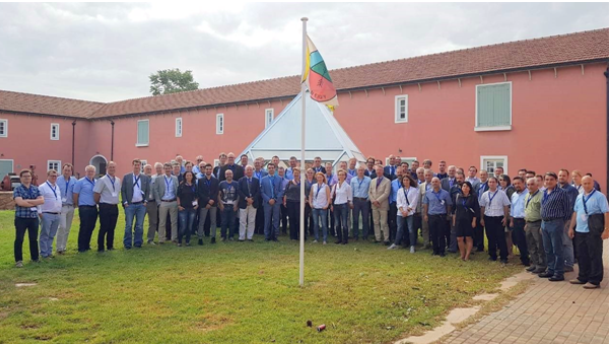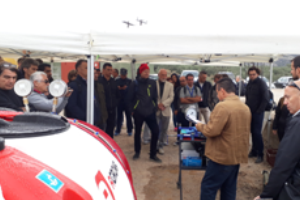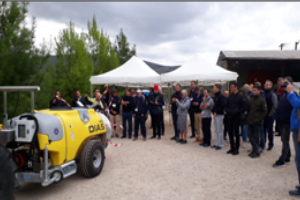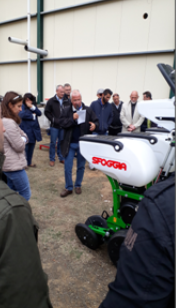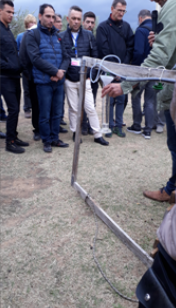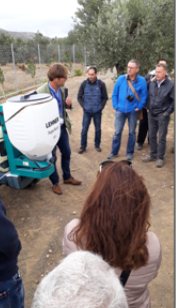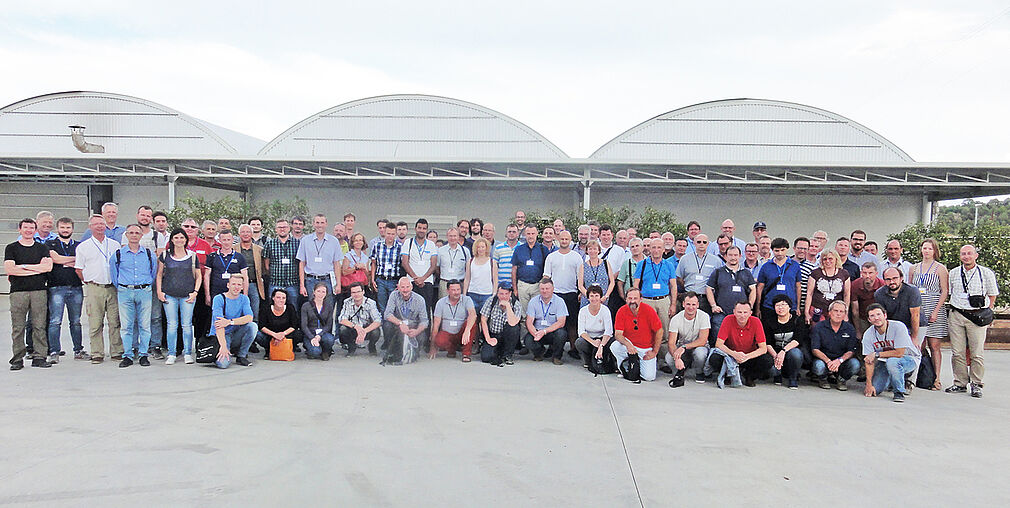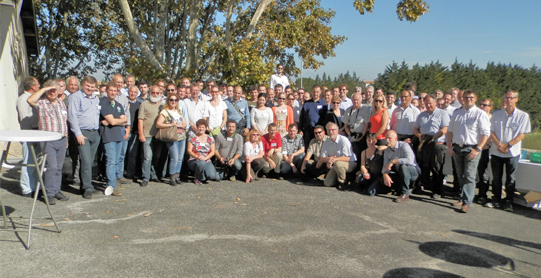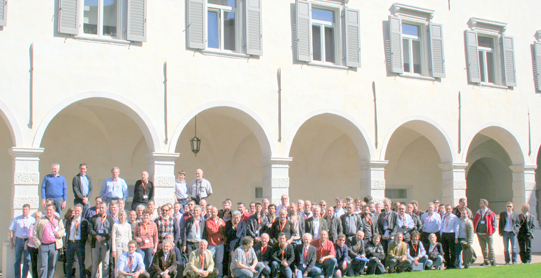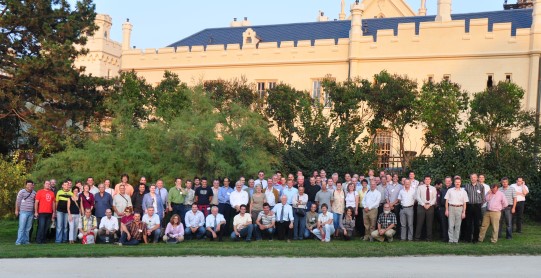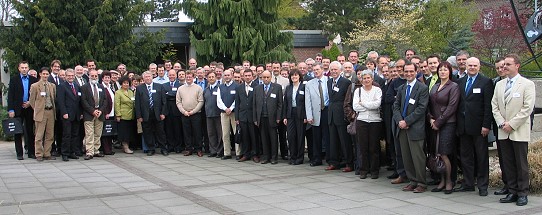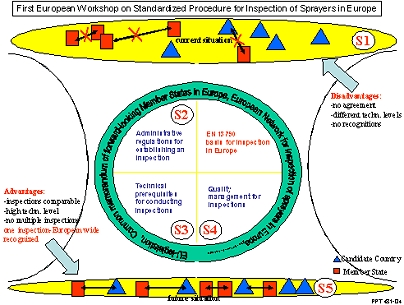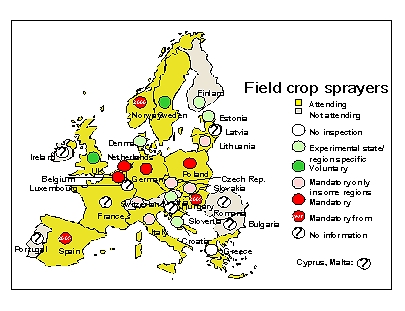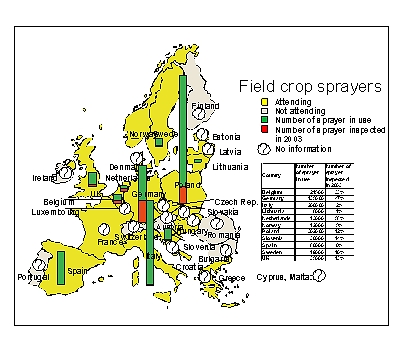Inhalt: Workshops
The SPISE Working Group was established during the first SPISE workshop 2004. There the participants welcomed the thought that a working group should work on further steps for the harmonisation and mutual acceptance of equipment inspections and should prepare a second European SPISE-Workshop. A constant exchange of information should be made possible between the working group and consultations going on between the EC and MS on improving the sustainability of plant protection.
8. SPISE Workshop 2023
8. SPISE Workshop 2023 (Presentations)
-
(01) Jaco Kole (The Netherlands)
Introduction to the Workshop
( pdf )
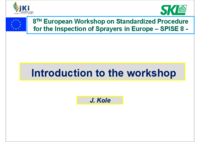
-
(02) E. Liegeois (DG SANTE E.4)
PAE and digital tools from the angle of Risk Mitigation Measures in the context of authorisations of pesticides
( pdf )
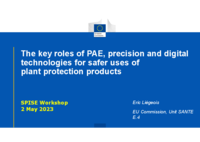
-
(03) H. Wehmann (Germany)
Status Quo of inspection in EU: the results of SPISE enquiry
( pdf )
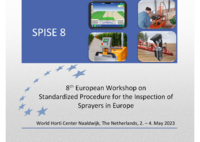
-
(04) J. Ottenheim (The Netherlands)
The importance of the PAE inspection from the Crop Protection Industry point of view
( pdf )
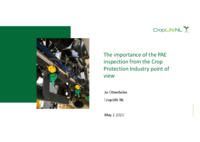
-
(05) M. Steinbusch (The Netherlands)
Experiences and challenges in PAE inspection activities
( pdf )
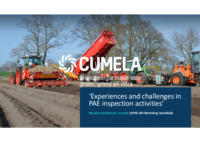
-
(06) C. Schulze Stentrop (Denmark)
25 years of sprayer inspection – report from a sprayer manufacturer
( pdf )
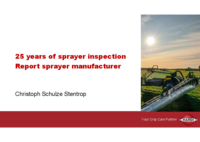
-
(07) N. Bouchekoum (France)
Development of a training course on sprayer calibration and settings based on the sprayer inspection database in France
( pdf )
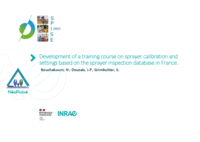
-
(08) J. Declercq (Belgium)
Experiences and challenges in the inspection of greenhouse and ornamental sprayers in Belgium
( pdf )
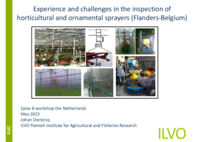
-
(09) E. Gil (Spain)
BTSF training course on Pesticide Application Equipment: Eight years of education on inspection benefits around Europe
( pdf )
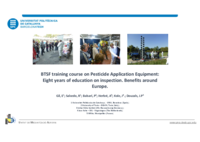
-
(10) P. Pelt (Luxembourg)
BTSF training course on Pesticide Application Equipment: Eight years of education on inspection benefits around Europe
( pdf )
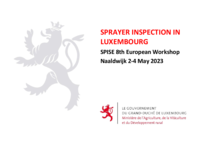
-
(11) E. Gil (Spain)
Inspection of sprayers in use out of Europe: some experiences in South America
( pdf )
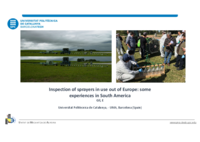
-
(12) P. Harašta (Czech Republic)
Experience in Czech Republic
( pdf )
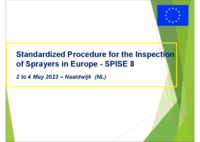
-
(13) C. Michael (Cyprus)
Experience and challenges in inspection activities in Cyprus
( pdf )
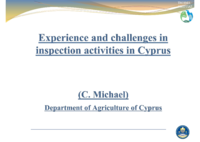
-
(14) J. Declercq (Belgium)
Belgian national PAE register
( pdf )
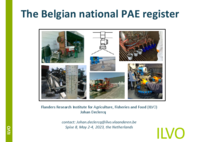
-
(15) G. Doruchowski (Poland)
In-farm self-inspection and calibration of sprayers – SPISE ADVICE quick guides and manuals
( pdf )
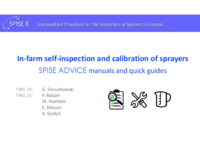
-
(16) P. Marucco (Italy)
Proposal of a methodology for the functional inspection of a Fixed Spray Delivery System (FSDS)
( pdf )
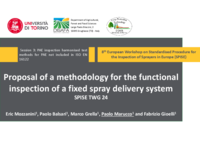
-
(17) F. Quigley (Ireland)
Testing of boom sprayer <3m
( pdf )
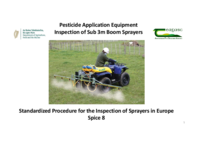
-
(18) T. Anken (Switzerland)
Possible testing procedures for spot sprayers
( pdf )
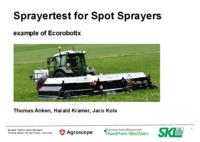
-
(19) A. Herbst (Germany)
Electronic controls and assistance systems – challenges for sprayer inspection
( pdf )
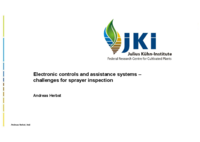
-
(20) J. K. Wegener (Germany)
New spraying technologies and their impact on control of sprayers in use
( pdf )
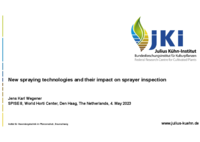
-
(21) N. Bjugstad (Norway)
Challenges regarding the use of new spraying technologies
( pdf )
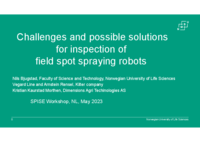
-
(22) C. Schulze Stentrop (Denmark)
Is a specific testing protocol required for online and offline application systems?
( pdf )
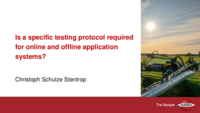
-
(23) I. Forman (United Kingdom)
NSTS training, qualification and auditing of machine Examiners
( pdf )
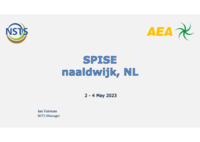
-
(24) J. Kole (The Netherlands)
Certification of the workshops in the Netherlands, replacing the recognition
( pdf )
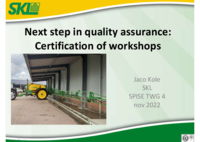
-
(25) J. Kole (The Netherlands)
General Conclusions
( pdf )
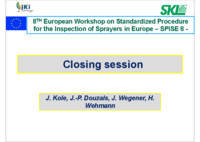
7. SPISE Workshop 2018
External Link: Proceedings - 7th SPISE Workshop
The 7th SPISE Workshop took place on 26th to 28th September, 2018 in the Conference Amphitheater, Agricultural University of Athens, Lear Odos 75, 1855 Athens, GREECE
The SPISE 7 Workshop took place at Athens, Greece, on 26 to 28 September 2018. About 100 participants from 24 European Countries took part. The locally organisation was under the responsibility of Institute for Bio-Economy & Agro-Technology of the Center of Research and Technology Hellas (www.ibo.certh.gr), Agricultural University of Athens (www.aua.gr) and the Greek Crop protection Association (www.esyf.gr), in a close collaboration with the reference laboratory for PAE inspection in Greece of ELGO-DEMETER. The workshop site was the Conference Amphitheatre, Agricultural University of Athens, Iera odos 75, 11855 Athens, GREECE. The Workshop was held by the SPISE Working Group (SWG). This is a cooperation between representatives from Belgium, Germany, France, Italy and the Netherlands.
Lectures, practical activities and visits had been organized for the two and a half days. Aspects as inspector’s training, the necessity of new standards, SPISE advices on how to inspect sprayers not included in ISO 16122 series, quality control of inspection workshops and other relevant aspects had been discussed. Inspection procedures had been partly explained at the presented equipment. The hosting venue is close to a very productive and intensive agricultural area occupied mainly from orchards, allowing to consider aspects focused on inspection of different sprayers and specifically of those used in Olives and Citrus and minor PAE, during the technical tour.
After the opening made by the SPISE WG Chairman Paolo Balsari and a welcoming address given by a representative of the Ministry of Agriculture the Workshop began with a round table session chaired by S. Fuentas and P. Balsari. The first speaker G. Granado-Lois – the representative from the Commission EC – DG Health and Food Safety -Directorate F made a presentation on “Current implementation of inspections of pesticide application equipment in EU following SUD requirements”. Further speakers reported on “Status Quo of inspection in EU: The results of a SPISE enquiry” (H. Wehmann – JKI - DE); “The experience of the mandatory sprayers’ inspection in Greece” (A.T. Balafoutis – iBO/CERTH - GR); “The inspection quality assurance: present situation and needs” (J. Langenakens – AAMS - BE); “The CEMA promotion of the inspections of brand new PAE” (C. Schulze Stentrop – CEMA - DK) and “The importance of the PAE inspection from the Chemical Industry point of view” (M. Roettele – ECPA - DE).
The attendance and the involvement and interest of Mr. Granado-Lois as representative from DG SANTE F are seen as a sign of recognition for the work done by SPISE.
The content of the following 6 specific sessions held during the first and the third day was prepared by the Technical Working Groups (TWGs) which were installed at the SPISE 4 workshop at Lana in 2014. In detail, the following sessions were offered:
- Session 1: Present experiences and challenges in inspections activities
Chairmen: E. Gil, N. Bjugstad - Session 2: Common procedures for Pesticide Application Equipment (PAE) risk assessment and for the evaluation of environmental benefit of the inspection
Chairmen: B. Huyghebaert, T. Bals - Session 3: PAE inspection harmonised test methods for PAE not included in ISO EN 16122 series
Chairmen: F. Solanelles, A. Sedlar, H. Wehmann - Session 4: Inspection quality: “Certification” of the Workshop activity (quality assurance) included the certification of devices/instruments used for the inspections
Chairmen: J. Kole, P. Harašta - Session 5: Additional Workshop activities including PAE adjustment
Chairmen: J. K. Wegener, A. Balafoutis - Session 6: Inspectors training harmonization and refreshment
Chairmen: E. Nilsson, H. Kramer
At the reception desk the participants were provided with printed versions of already 9 SPISE Advices. These booklets are also free downloadable from the SPISE website. They are parts of a series of publications prepared by the SPISE TWGs and could be useful to fulfil the requirements of the Directive 2009/128/EC (Sustainable Use Directive). The SPISE Advices should be implemented and applied where no harmonized standards are available.
30 presentations given by the participants plus 13 posters showed the ongoing activities in the Member States. Also some still existing difficulties regarding the implementation mandatory inspections systems in the MS came up for discussion. About two years after the deadline of 26th of November 2016 most of the MS cannot guarantee that all contemplable PAE in professional use were inspected at least one time
The second day was dedicated to practical demonstration of the sprayers’ inspections activities.
The first demonstration was held on an olive and orange farm. Here the complete inspection procedure of a sprayer used in orange trees was presented (fig. 2) and explained the main aspects to be considered to properly adjust a sprayer (fig. 3).
The second stop of the excursion was at the “Melas” olive mill. The Company is situated in Ligoutio, at the municipality of Epidaurus in the Peloponnese, It is engaged in manufacturing, packing, marketing and exporting extra virgin olive oil since 1992. A family business consisting of organic olive groves of an annual capacity of 650 tons.
Here in the olive grove of the mill were conducted and explained the inspection of
- micro granulator (Fig. 4)
- controlled droplet application equipment (CDA) (Fig. 5) and
- slug pellet applicator (Fig. 6).
After this practical conduct of the inspection processes a discussion followed where the workshop quality assurance regarding the minor PAE inspection was focused on.
Acknowledgement:
Special thanks to the
- Institute for Bio-Economy & Agro-Technology of the Center of Research and Technology Hellas (www.ibo.certh.gr),
- Agricultural University of Athens (www.aua.gr) and the
- Greek Crop protection Association (www.esyf.gr)
for the excellent hospitality and fruitful co-organization.
6. SPISE Workshop 2016
External Link: Proceedings - 6th SPISE Workshop
The SPISE 6 Workshop took place at Barcelona, Spain, on 13 to 15 September 2016
About 100 participants from 27 European Countries and from Extra-European Countries (China and Iraq) took part. The locally organisation was under the responsibility of the Escola Superior d’Agricultura de Barcelona, Universitat Politécnica de Catalunya (UPC), Spain. The workshop site was the Campus del Baix Llobregat, Castelldefels. The Workshop was held by the SPISE Working Group (SWG), to which representatives from Belgium, Germany, France, Italy and the Netherlands belong, in collaboration with the Escola Superior d’Agricultura de Barcelona, Agricultural Ministry and the Generalitat of Catalonia.
The 6th edition of SPISE workshop covered important aspects: The recently published harmonized EN ISO 16122 for inspection of sprayers in use, and the deadline according the EU Directive 2009/128/EC – November 26th 2016 – for the accomplishment of the official mandate. It was an interesting opportunity to evaluate the present situation on MS and to understand the difficulties encountered and the necessary actions needed to solve them. It was also possible for the participants to evaluate and discuss about the recently entered in force harmonized standard on the inspections of sprayers used in greenhouse (ISO EN 16122-4)
The Workshop began with a round table session, where a representative from the Commission (P. Kiss) made a presentation on “Current implementation of inspections of pesticide application equipment in the EU following SUD requirements”. Further speakers reported on “Status Quo of inspection in EU: The results of a SPISE enquiry” ( H.Wehmann –JKI-DE) “The PAE inspection in Spain and Catalonia” (A. Goutan, Generalitat of Catalonia - ES), “The experience of the mandatory sprayers inspection in Greece” (T. Balafoutis, University of Athens- GR), “The point of view of a farmer” (C. González, COPACOGECA-ES) and “The advantage of sprayer inspection from the dealer’s point of view” (E. Hogervorst, CLIMMAR- NL).
The attendance and the involvement and interest of Ms. Kiss as new representative from DG SANTE are seen as a sign of recognition for the work done by SPISE.
The content of the specific following 7 sessions was prepared by the Technical Working Groups (TWGs) which were installed at the SPISE 4 workshop at Lana in 2014. In detail the following sessions were offered:
- Session 1: Inspection of brand new sprayers (TWG 1)
Chairmen: E. Gil, C. Schulze-Stentrop - Session 2: Definition of a common risk assessment procedure for Pesticide Application Equipment (PAE) to be exempted from the inspection (TWG 2)
Chairmen: B. Huyghebaert, N. Bjugstad - Session 3: Sprayer inspection harmonised test methods (TWG 3)
Chairmen: J.-P. Douzals, V. Polvêche - Session 4: “Certification” of the Workshop activity (quality assurance) included the certification of devices/ instruments used for the inspections (TWG 4)
Chairmen: J. Kole, P. Harašta - Session 5: Harmonise the training of the inspectors to achieve the same professional level of the inspections (TWG 5)
Chairmen: E. Nilsson, H. Kramer, H. Wehmann - Session 6: Present experiences and problems in inspections activities
Chairmen: E. Gil, H. Kramer, J. Kole - Session 7: SPISE TWG activities and SPISE advice on PAE not yet considered by harmonised Standards
Chairmen: J. Wegener, P. Balsari
More than 40 presentations from the participants plus 7 posters showed the on going activities in the Member States and the current situation regarding the introduction of plant protection equipment mandatory inspections in the MS.
The attending countries were able to report on the present activities and was underlined the installation of the inspection systems in all MS.
During the discussions assigned to each session it was determined repeatedly that due to different reasons most of MS cannot guarantee to complete the first inspection of all PAE in professional use by the deadline of 26th of November 2016.
As also mentioned in the frame of the 5th SPISE Workshop there is a need for specific advices to fulfil the requirements of the Directive 2009/128/EC (Sustainable Use Directive) that should be implemented and applied. In the following it was decided to prepare “SPISE Advices” to each of the issues considered by the SPISE TWGs. In the meantime the first Advices are published and free downloadable from the SPISE Website.
The second day was dedicated to practical demonstration of the sprayers’ inspections activities with particular effort to the inspections of sprayers used in greenhouse.
The first demonstration was held at the Finca Agustí farm, where are cultivated outdoor vegetables as celery and tomatoes. The participants were divided in three groups and were invited to follow/conduct inspections on a field crop sprayer, an orchard sprayer and also an orchard sprayer equipped with a spray gun. For this purpose the colleagues of UPC and Agricultural Mechanization Centre (CMA) developed a special test report which was explained and filled in step by step by appointed tutors.
The next demonstration was at the company of Agromillora Iberia, which is an international nursery dedicated to the production of fruit and olives trees. The focus here was laying on the inspection of sprayers for greenhouse application following the new harmonized standard (ISO EN 16122). Also here a specific test report prepared by UPC and CMA was the basis for the group work. Furthermore the groups participated in a presentation of a special fogger equipment and followed a guided tour through the greenhouses of the company. At the end of the demonstration a general discussion on this new standardized inspection methodology was held and operative problems underlined.
5. SPISE Workshop 2014
External Link: Proceedings - 5th SPISE Workshop
The SPISE 5 Workshop took place at Montpellier, South of France, on 15 to 17 October 2014
About 100 participants from 23 European Countries and from Extra-European Countries (Brasil and Canada) took part. The locally organisation was under the responsibility of the National Research Institute of Science and Technology for Environment and Agriculture IRSTEA, Montpellier, France. The workshop site was the Agropolis conference centre which is situated in a very short distance to the IRSTEA building. The Workshop was held by the SPISE Working Group (SWG), to which representatives from Belgium, France, Italy, the Netherlands and Germany belong. For the first time Prof. P. Balsari had the chairmanship for a SPISE workshop.
The aim of the SPISE 5 Workshop was to support further the introduction of inspections of plant protection equipment already in use in the Member States (MS) of the EU. Following the publication of Directive 2009/128/EC in October 2009, the Member States have to introduce technical inspections for plant protection equipment at regular intervals and ensure that all items of plant protection equipment have been inspected at least once by 2016. The Directive determines the key points. The development of procedures between the MS is left to the Member States according to the principle of subsidiarity. They have a fair amount of leeway and are able to take their own experience and conditions into consideration.
The Workshop began with a round table session, where a representative from the Commission (K. Nienstedt) presented the opinion and expectations of DG Sanco. “Inspections of pesticide application equipment in the context of European legislation” was the title of her presentation. Further speakers reported on ISO 16122 harmonized standards (V. Polvêche, FR), “The experience of the introduction of the inspection of sprayers in use from one Member State’s point of view” (A. Fjelstedt, DK), “What is the farmer’s EU feeling from Copa Cogeca’s standpoint” (JF. Proust, FR) and “Sprayer inspection issues – the testimony of a professional organization - Federation des Fruits et Legumes” (J.-P. Douzals, FR).
The attendance and the involvement of the representative from DG Sanco are seen as a sign of recognition for the work done by SPISE and should not go unmentioned.
The subject matter for the sessions originally resulted from the sections of Article 8 of Directive 2009/128/EC. The content of the sessions was prepared by the Technical Working Groups (TWG) which were installed at the SPISE 4 workshop at Lana in 2014.
- Session 1: Inspection of new sprayers before their delivery (TWG 1)
Chairmen: E. Gil, C. Schulze-Stentrop - Session 2: Train application – State of the art and parameters to be inspected (TWG 7)
Chairmen: J. Kole, P. Balsari, H. Kramer - Session 3: Correct use of sprayer inspection harmonized test methods and definition of additional test methods for application equipment not covered by harmonized standards (TWG 3)
Chairmen: J.-P. Douzals, V. Polvêche - Session 4: “Certification” of the workshop activity (quality assurance) including test facilities (TWG 4)
Chairmen: J. Kole, P. Harašta - Session 5: Harmonise the training of the inspectors to achieve the same professional level of the inspections (TWG 5)
Chairmen: E. Nilsson, H. Kramer, H. Wehmann - Session 6: Minimum workshop facilities necessary to make an appropriate sprayer adjustment of orchard sprayer at the workshop during the inspection (TWG 6)
Chairmen: P. Balsari, J. Langenaakens, A. Herbst - Session 7: Definition of a common risk assessment procedure for Pesticide Application Equipment (PAE) to be exempted from the inspection (TWG 2)
Chairmen: B. Huyghebaert, N. Bjugstad
Nearly 40 presentations from the participants plus 12 posters showed the ongoing activities in the Member States and the current situation regarding the introduction of plant protection equipment in the MS.
During the discussions assigned to each session it was determined repeatedly that regarding several facts and circumstances there is a need for specific recommendations or advices in which way the requirements of the Directive 2009/128/EC (Sustainable Use Directive) should be implemented and applied. Against this background it was decided to prepare “SPISE Advices” to each of these issues.
On the second day an excursion was following. The first highlight were the widespread visit to the testing facilities of IRSTEA and the demonstration of inspections of sprayers plus the testimony of an inspector by GIP Pulvés. The program was topped off with the demonstration of the “Ecospray Viti test bench” where different application qualities for wine-growing were demonstrated. The next item on the programme was the visit of the winery of the Domaine du Chapitre, Villeneuve les Maguelonne. Here the participants were informed concerning the special requirements on the vine-growing in that region. And finally during the visit of the Experimental station for horticulture (CEHM) at Marsillargues the participants were able to gather information on the wide range of application technology in fruit-growing and horticulture plus their inspection. An exhibition of orchard sprayers and of test equipment for the measurement of the vertical spray distribution offered extended information. The special circumstances in the surrounding of the Montpellier region require a comprehensive control of mosquitoes. The different equipment used for this purpose plus their inspection possibilities were demonstrated and explained by the representative of the “Interdepartmental Agreement for mosquito control of the Mediterranean coast (EID)”.
4. SPISE Workshop 2012
External Link: Proceedings - 4th SPISE Workshop
The SPISE 4 Workshop took place in Lana, South Tyrol, on 27 to 29.03.2012
More than 100 participants from 29 European countries took part.The Workshop was organised by the SPISE Working Group (SWG), to which representatives from Belgium, France, Italy, the Netherlands and Germany belong (Chairman: Dr.-Ing. H. Ganzelmeier).
The aim of the SPISE 4 Workshop was to support the introduction of inspections of plant protection equipment already in use in the Member States (MS) of the EU. Following the publication of Directive 2009/128/EC in October 2009, the Member States have to introduce technical inspections for plant protection equipment at regular intervals and ensure that all items of plant protection equipment have been inspected at least once by 2016.
The Directive determines the key points. The development of procedures between the MS is left to the Member States according to the principle of subsidiarity. They have a fair amount of leeway and are able to take their own experience and conditions into consideration.
The Workshop began with a round table session, where a representative from the Commission (A. Rotteveel) presented the opinion and expectations of DG Sanco. Further speakers reported on the national plan of action (Prof. Freier, DE) and on previous experience with plant protection equipment inspections and their implementation in the Member States (J. van Wenum, NL; Dr. Waldner, IT; H. Wehmann, DE). The involvement of the representative from DG Sanco is also seen as a sign of recognition for the work done by SPISE.
The subject matter for the sessions resulted from the sections of Article 8 of Directive 2009/128/EC:
- Session 1: Inspections at regular intervals – Inspection of new equipment
- Session 2: Member States may apply different timetables and inspection intervals with exceptions following a risk assessment and exempt handheld pesticide application equipment or knapsack sprayers
- Session 3: The inspections shall verify that pesticide application equipment satisfies the relevant requirements
- Session 4: Member States shall establish certificate systems for mutual recognition of the certificates
In addition, two further sessions were included:
- Session 5: Training
- After Dinner Speech: Are sprayer calibration, adjustment related to the canopy structure and drift reducing technology added values for orchard/wine growers
Contributions from the participants included 10 posters which presented ongoing activities in the Member States and the current situation regarding the introduction of plant protection equipment in the MS.
The After Dinner Speech was geared around becoming acquainted with the technical inspection of air-assisted sprayers developed by the South Tyrolean Extension Service for Fruit- and Wine growing in Lana, which provides for instructions on calibration and adjustment for each individual piece of inspected equipment. The visit to a testing workshop for air assisted sprayers in Auer, where the scope of and the practical procedure for the technical inspection were introduced and then explained, pursued the same aim.
The question is whether it makes sense and would be practical to integrate one or several tools from the Extension Service into the compulsory inspection which takes place at regular intervals according to Article 8 (and must be carried out according to the harmonised EN standards throughout the Member States) as an addition and on the request of growers.
This could result in a win-win situation with considerable advantages for fruit growing, i.e. fruit growers themselves, in addition to the advantages for the consumer, the public and environmental protection.
On the second day an excursion took place to a company called Lochmann in Vilpian (a well-known manufacturer of air assisted sprayers for fruit growing and viticulture), to research centres in San Michele (presentation of research results on drift reducing technology) and Laimburg (demonstration of air assisted sprayers particularly suited to slopes in viticulture) as well as to a testing workshop of the Extension Service in Auer. In Auer, the technical inspection of an air assisted sprayer was shown using local testing facilities. In an orchard nearby, the spray pattern from the equipment which had been adjusted could be viewed.
The participants were able to gather information on the wide range available from an exhibition of testing facilities by manufacturers from Belgium, Germany and Italy.
Many matters could be discussed and some of them clarified during the Workshop. However, many issues remained unsolved. These are to be brought together in Technical Working Groups and specified further.
The main issues include:
- How to deal with minor defects/brand new sprayers?
- Define a certificate system for mutual recognition
- Define a simplified quality assurances system
- Define a common risk assessment procedure for excluding PAE from the inspections
- Define a procedure for calibration, sprayer adjustment and drift reducing technology as added values
- Collect from MS available training material and make it downloadable on SPISE website
- Develop a SPISE database relevant for monitoring, mutual recognition …
This also shows the effort made by the participants to not only discuss matters, but to also be actively involved in establishing procedures for equipment inspections. In this way technical criteria and procedures within SPISE will be concretised and proposed which contribute to a uniform approach in the MS and concerning mutual recognition.
The survey on the state of equipment inspections in the MS as carried out before each SPISE Workshop and consequently also in the run-up to SPISE 4 shows considerable progress compared to the results from 2009:
The amount of plant protection equipment inspected in 2011 in the EU (all MS) increased from 230,000 to 300,000. The intervals set by the MS between inspections are 1 to 5 years.Up to now, 16 MS have made use of the exceptional cases according to Article 8.3 of Directive 2009/128/EC and have exempted certain equipment from the inspection or have set different inspection intervals for this. According to notifications from the MS, there are now obviously less items of plant protection equipment. There were less field sprayers in 2011 (1.25 million) compared to 2009 (1.3 million). Air assisted sprayers followed the same trend during this period from 980.000 to 950.000.
The excellent preparation and organisation of the Workshop by the Extension Service in Lana should be noted, and also the constructive and committed attitude to SPISE.
The chairman of the SPISE Working Group, Dr.-Ing. Heinz Ganzelmeier, on whose initiative the SPISE was founded and who was head of the four Workshops, has now passed on this task to Professor Balsari of Turin University (who has also been a member of the organisational team since 2004) since Dr. Ganzelmeier will be retiring at the end of this year.
The proceedings of the SPISE4 workshop will be printed and available as soon as possible.
3. SPISE Workshop 2009
External Link: Proceedings - 3rd SPISE Workshop
The SPISE 3-Workshop took place from 22 to 24 September 2009 at Brno (CZ)
The SPISE 3-Workshop took place from 22 to 24 September 2009 at Brno (CZ) and was attended by 100 participants from 27 European countries. The Workshop was organised by the SPISE Working Group (SWG), to which representatives from Belgium, France, Italy, the Netherlands and Germany belong (Chairman: Dr.-Ing. H. Ganzelmeier)
The aim of the Workshop was to discuss Article 8 of the Framework Directive (the inspection of plant protection equipment already in use) and to reach conclusions for implementing equipment inspections in the Member States. The participants came from testing and research institutes, administration departments and companies and the majority possessed technical expertise so that in particular practical implementation was the focal point of the Workshop.
The Workshop was opened by Mr. Hnizdil from the State Pyhtosanitory Admininstration Department in Prague.
Two representatives from the European Commission were present and both gave a presentation at round table sessions:
Mrs van Tongelen, DG-Environment
-Directive of the European Parliament and the Council establishing a framework for Community action to achieve the sustainable use of pesticides -
Mr. Fräser, DG Enterprise,
- Directive of the European Parliament and the Council on machinery for pesticide application, amending Directive 2006/42/EC of 17 May 2006 on machinery.
Representatives from ECPA, CEMA, COPA und JKI/AT also contributed to the round table session by giving presentations.
The individual sections of Article 8 were presented, explained and discussed in the 6 sessions which followed.
On the evening of the first day, contributions concerning the training of inspection personnel and on software solutions for compiling and analysing data and inspection facilities were presented under the agenda item "Optional Evening Activities" and also several posters.
On the 2nd day there was an excursion to inspection workshops in the Czech Republic and Slovakia. This excursion was welcomed enthusiastically by the participants because the inspection workshops demonstrate equipment inspection procedures in practice and there are always positive examples to see and other cases in need of improvement.
The results of the workshop can be summarised as follows:
- Mrs von Tongelen asked the participants to take part in the 2nd meeting of experts (in accordance with Article 18) which is planned for June 2010.
- Mr Fraser explained why the certification of new equipment is organised by the Machine Directive and the inspection of plant protection equipment already in use by the Framework Directive.
- Mr Hagenvall (ECPA) emphasised that equipment which works well is an important prerequisite for the complete efficacy of plant protection products and for avoiding negative effects.
- Mr Oldenkamp (CEMA) welcomed the harmonisation of equipment inspections because this means that national regulations will be phased out. He supports the inspection of new equipment by the manufacturers at their factory and before delivery to the customers. (This approach is already used successfully for some neighbouring Member States based on bilateral agreements).
- Mr. Rademacher (COPA) would welcome a similar inspection for plant protection equipment already in use in the Member States and called for the harmonisation of the inspection procedure and inspection intervals.
- Mr. Wehmann reported on the results of a survey in the Member States on the present situation of the inspection procedure for plant protection equipment already in use. He established the fact that the compulsory inspection has now been introduced to all participating countries or that this is definitely intended in the next few years.
- It was considered practical and equivalent for the inspection of plant protection equipment to be carried out both by officially certified inspection workshops and offices of the official service (as is the case, for example, in Belgium, Germany and the Netherlands).
- Most Member States which have not yet had as much experience with plant protection equipment inspections will keep to inspection intervals of 5 years; other Member States considered a shorter interval to be more practical.
- Inspections of new equipment after 5 years at the latest following their first use, as provided for in Article 8 § 2, is not seen as being particularly practical. An inspection which takes place immediately at the manufacturer's is considered as being practical and is supported.
- The question also arose as to whether an operator can have his plant protection equipment inspected in a neighbouring Member State where the inspection is easier and cheaper.
- It remained open as to whether Member States have to offer inspections for all plant protection equipment or whether plant protection equipment owners can also be referred to offers from other Member States (e.g. for aircraft).
- It has to be clarified for which types of construction the Member States may use different schedules and inspection intervals and which types of construction may be exempt from inspections.
- It has to be clarified how the assessment of risks for human health and the environment, including an assessment of the scope of use of the equipment, should be carried out in order to be able to examine certain types of construction independently of the regular inspection intervals or to exclude them entirely from the inspection. The question arose as to whether EN/ISO 12100 - Safety of machinery - General principles for design, risk assessment and risk reduction (ISO/DiS 12100:2009) can be used as a basis for the required risk assessment.
- When introducing equipment inspections to the Member States it is considered suitable and practicable to limit these first of all to the type of construction, for which the corresponding EN standards have already been published in the Offical Journal (EU). This is only expected for field sprayers and air-assisted sprayers for bush and tree cultures at short notice at the moment. Other types of construction could then be included in the obligatory examination as soon as the corresponding standards are available.
- In conjunction with the inspection of handheld plant protection equipment and knapsack sprayers, training operating personnel is considered very important. Studies have shown that the 'human' factor is just as important as the factor 'equipment'.
- The Commission has assigned the CEN the task of drawing up standards for the inspection of plant protection equipment. A first meeting of the CEN/TC 144/WG 3 which has been assigned the task took place on 20 and 21 October 2009 in Paris.
- The participants expected that this standardisation work by the WG 3 would be promoted and be high up on the list of priority.
- Alternatives for inspecting plant protection equipment without having mandated standards available were discussed and demonstrated by the JKI/AT using examples.
- In accordance with Article 8 § 5 operators are obliged to carry out regular calibrations and technical checks. To this end interesting case studies were shown and explained.
- The required certification regulations for the mutual recognition of inspections can be limited to the submission of a valid inspection report and a valid inspection sticker on the plant protection equipment. A separate and more detailed certificate is not deemed necessary.
- The inspection report is stipulated by EN 13790. The inspection sticker itself (shape, print design) was not discussed in any greater detail. The question of whether the German method of still issuing an inspection sticker despite minor deficits would meet with general approval could not be clarified for definite.
- These 'minor deficits' still have to be defined for further types of construction. Similarly a decision is to be made on whether this should be at CEN or MS level.
- It was suggested to orientate the colour of the inspection sticker around ISO 10625 (colour coding for nozzles).
- Furthermore, the criteria for not issuing inspection stickers and for recognition and monitoring officially recognised inspection workshops were addressed. In this context, reference was made to exemplary regulations from the Netherlands, Belgium and Germany which can be found on the SPISE website.
- Monitoring recognised inspection workshops was seen as essential, harmonisation was considered necessary. To this end it was suggested to compile an EU database. Accreditation according to ISO 9000/ISO 17020 was seen as too complicated and costly.
- The draft prepared and presented by the SPISE Working Group, 'Proposal for uniform enforcement of inspection in the Member States', can be seen as a contribution on how equipment inspections according to Article 8 of the Framework Directive can be implemented in national legislation. Particularly technical and administrative aspects are taken into consideration.
- A concluding recommendation/comment was compiled on the basis of the previous SPISE Workshops.
- The SPISE Working Group intended to report to the Commission on the SPISE 3-Workshop in the near future.
2. SPISE Workshop 2007
External Link: Proceedings - 2nd SPISE Workshop
2nd European Workshop on Standardised Procedure for the Inspection of Sprayers in Europe – SPISE- from 10 - 12 April 2007 in Straelen
Nach dem ersten Workshop zur Kontrolle von Pflanzenschutzgeräten in Europa vom 27. bis 29. April 2004 in Braunschweig, fand nunmehr der zweite SPISE-Workshop vom 10. bis 12. April 2007 statt, zu dem die Biologische Bundesanstalt/Fachgruppe Anwendungstechnik Experten der Gerätetechnik aus ganz Europa nach Straelen in das Informations- und Ausbildungszentrum für Gemüsebau eingeladen hatte.
Ziel dieses Workshops war es, die Experten aus den Mitgliedstaaten über die von der Europäischen Kommission im Rahmen der Thematischen Strategie für einen nachhaltigen Einsatz von Pflanzenschutzmitteln beabsichtigte Einführung einer gesetzlichen Regelung für in Gebrauch befindliche Pflanzenschutzgeräte (Pflichtüberprüfung) zu informieren und über die weiteren erforderlichen technischen, organisatorischen und administrativen Regelungen in den Mitgliedstaaten zu beraten.
Eine Exkursion zu Kontrollstellen in Belgien, den Niederlanden und in Deutschland, die seit mehreren Jahren eine Pflichtkontrolle eingeführt haben, sollte auch die landesspezifischen Unterschiede in der praktischen Vorgehensweise verdeutlichen, die im Ergebnis jedoch eine zuverlässige und technisch hochwertige Überprüfung der im Einsatz befindlichen Feldspritz- und Sprühgeräte in den genannten Mitgliedstaaten sicherstellen.
Der Workshop mit mehr als 100 Teilnehmern aus 27 europäischen Ländern wurde eröffnet von Frau Dr. Schorn, Leiterin des Referats Pflanzenschutz 517 im BMELV, die damit die Bedeutung der Initiative der Biologischen Bundesanstalt zur europäischen Kontrolle von Pflanzenschutzgeräten unterstreicht. Prof. Dr. Böhmer, Pflanzenschutzamt Bonn/Münster, hat als Hausherr die Tagungsteilnehmer begrüßt und mit der Bereitstellung des Tagungszentrums in Straelen besonders gute Voraussetzungen für eine gelungene Tagung geschaffen hat.
Eingeleitet wurde die Veranstaltung durch 4 Grundsatzreferate
- zur Thematische Strategie für einen nachhaltigen Einsatz von Pflanzenschutzmitteln
- zum Qualitätssicherungssystem- Landwirtschaft des EurepGAP
- zur Position der CEMA (Europäischer Verband der Landmaschinenhersteller)
- zu einer Umfrage zur Gerätekontrolle in den Mitgliedstaaten.
In sieben Sessions wurden weitere 18 Beiträge und 20 Poster von der Teilnehmern vorgestellt.
Abschließend verabschiedeten die Teilnehmer eine Resolution mit Empfehlungen, die bei den weiteren Beratungen zur Einführung einer Pflichtkontrolle in Europa Berücksichtigung finden sollten.
1. SPISE Workshop 2004
External Link: Proceedings - 1st SPISE Workshop
1st European Workshop on Standardised Procedure for the Inspection of Sprayers in Europe –SPISE
The inspection of sprayers, which means the periodic inspection of sprayers in use, was the theme of the first European workshop, which took place at the Federal Biological Research Centre for Agriculture and Forestry (BBA) in Braunschweig from 27 to 29 April 2004. The basis for the workshop was the publication of a European norm at the beginning of last year, in which the technical requirements for the inspection of field crop sprayers and air-assisted sprayers for bush and tree crop was determined for the whole of Europe. This is seen as an important component in the harmonisation of sprayer inspections in Europe.
The aim of the workshop was to introduce this new standard to all the European Member States and candidate countries and to promote its implementation to create a reliable sprayer inspection of high technical quality. Since in addition to countries such as Germany, Belgium, the Netherlands and Poland – which introduced a compulsory inspection for sprayers several years ago – other Member States and candidate countries are discussing and preparing themselves for the introduction of sprayer inspections, the timing of the workshop was very fortunate. Eighty experts from 20 Member States and candidate countries came to Braunschweig.
The President of the BBA, Dr. Georg F. Backhaus, and the head of Plant Protection Department at the Ministry of Consumer Protection, Food and Agriculture (BMVEL), Dr. Petzold, opened the workshop and in doing so, emphasised the significance of this issue and this European initiative of the BBA. The Commission was also represented and presented its views with regard to possible ways of governing sprayers. The technical part of the Workshop was introduced by two keynotes, presented by Mr. Liegeois on the subject of "Thematic strategy on the sustainable use of pesticides: an action plan to improve good plant protection practices throughout Europe“ and Dr. Ganzelmeier on "European Standard EN 13790, the basis for sprayer inspections in Europe".
Mr. Liegeois emphasised in his presentation that the Commission has also included a number of measures for improving sprayer technology in the context of its environmental protection strategy. A first meeting of experts took place at the end of March 2004 in Brussels on aerial applications in the Member States. The SPISE workshop can be seen as the first European forum for exchanging experience and discussing measures for inspecting sprayers throughout Europe, and co-ordinating these in the future.
Dr. Ganzelmeier explained the first European standard EN 13790: work was started on this in the CEN/TC144 in 1997. It was published in the spring of 2003. First of all, this standard states, amongst other things, the following:
Over the past few years, the inspection of sprayers already in use has been introduced in various Member States and candidate countries. This development has been supported by public concern about possible hazards, and efforts to reduce the amount of plant protection products used. The three most important reasons for the inspection are
- the reduction of the risk to the environment through plant protection products,
- optimum plant protection using the least amount of plant protection product possible and
- the safety of inspection personnel.
In order to make the use of plant protection products in European agricultural production safe, requirements and test methods for the inspection of sprayers already in use must be determined. This is a step further in the same direction following the standardisation of requirements for new sprayers relevant to environmental protection. Furthermore, it is stated that sprayers can be inspected on a voluntary basis, but also as an obligatory inspection. In both cases, detailed official or legal agreements are necessary on, for example, the implementation of inspections, the authorisation of places allowed to carry out inspections, the intervals between inspections, and so on. This European standard now determines requirements and methods for inspecting sprayers which are already in use. Through visual inspections, performance tests and by carrying out measurements, compliance with the specified requirements can be examined. A total of about 40 different requirements are stated which have to be tested during the inspection and recorded in the inspection report.
According to Germany, there is merely one issue, regarding the measurement of the evenness of transverse distribution from field sprayers, which is not yet governed clearly. Two different test methods are still allowed: in addition to a cross-distribution test bench (patternator), the assessment of flow rate using individual nozzle measurements is allowed. The future will show whether the acknowledged equality of both methods works.
As already mentioned, this standard does not govern all aspects of the sprayer inspection. More extensive administrative regulations (S 2), technical prerequisites (S 3) and a quality assurance system (S 4) are needed, fig. 2. To be able to implement these associative measures in a binding form in all Member States and candidate countries when appropriate, further superordinate rules and regulations are necessary. This could be in the way of a binding legal regulation in the EU or a voluntary commitment of the Member States and candidate countries (memorandum, network). The following sections were therefore arranged as follows:
- S 1: Actual inspections in the Member States and candidate countries and their comparison with EN 13790
- S 2: Administrative regulations required for establishing an inspection
- S 3: Technical prerequisites required for conducting inspections
- S 4: Quality management for inspections
- S 5: Harmonisation of inspections for mutual recognition between Member States
The present situation regarding sprayer inspections in the Member States and candidate countries is clear by looking at fig. 3 and 4. It is marked at present by great differences between the Member States and candidate countries. It shows that at present, sprayer inspections are obligatory by law only in Germany, Belgium, the Netherlands and Poland. Several countries intend to introduce an obligatory inspection in the next few years. In several Member States or candidate countries, a voluntary sprayer inspection either exists or is in the process of being established. In many cases, the inspection is organised and implemented in a different manner, depending on the particular region.
In addition, the annual inspections deviate clearly from one another, even in countries which have already introduced obligatory inspections, fig. 4.
he presentations were complemented by posters, an exhibition of test facilities from European manufacturers/distributors in and around the testing hall of the Division for Application Techniques, and an excursion to approved inspection workshops.
The results of the SPISE-Workshop can be summarised as follows:
The sprayer inspection is seen by the participants as a major contribution to high quality environmental and operator protection as well as food safety. Most Member States and candidate countries are involved in the introduction of a sprayer inspection (pilot project, voluntary inspection or obligatory inspection). Particularly interesting was that the European Commission does not see the need for further technical requirements for sprayer already in use and for new plant protection equipment which go beyond EN 13790 and EN 12761. Representatives from the Member States and candidate countries propose a sprayer inspection which is uniform throughout the EU and endorse the implementation of EN 13790 by the Member States and candidate countries. It was also evident that in the Member States, the organisation, responsibility (private, state-approved) and consequences of the inspection (if requirements are not fulfilled) are governed in very different ways. Often, the inspection facilities do not fulfil requirements in accordance with EN 13790. The Member States and candidate countries use different test benches for measuring the vertical distribution of air-assisted sprayers. The Member States and candidate countries therefore see the need for further administrative and technical agreements which go beyond EN 13790, in the following areas:
- commitment to a voluntary / obligatory inspection
- organisation / competencies
- test procedure for both new and used sprayers
- approved inspection workshops
- definition of "minor defects"
- consequences if requirements are not met
- guidelines for introducing sprayer inspections.
The exchange of information between Member States / candidate countries is also seen as very important and should therefore be developed further.
The quality of the inspection is determined mainly by the inspection workshop, the authorised inspection personnel and the monitoring system for approved workshops. Only a few Member States have introduced a quality assurance system (e.g. accreditation in accordance with EN 45004).
The Member States/ candidate countries therefore see an urgent need for regulating (exchange of information) quality assurance, training inspection personnel and checking the testing equipment.
At present, several individual regulations exist in the different countries, which allow mutual recognition on a bilateral level (e.g. D / NL, B / NL).
An important prerequisite for the mutual acceptance of sprayer inspections is that EN 13790 is implemented throughout the whole of the EU. A sprayer inspection for the whole of the EU should therefore only be introduced on the basis of EN 13790.
Representatives from the Member States / candidate countries also endorse the implementation of EN 12761, which contains the requirements for new plant protection equipment.
Furthermore, representatives from the Member States / candidate countries endorse the implementation of a "European Steering Committee" to support the harmonisation of the sprayer inspection and to safeguard conditions of competition. Action is seen as necessary in the following areas:
- agreeing on the various regulations in the Member States and candidate countries,
- safeguarding a reliable and precise sprayer inspection,
- regular checks on inspection workshops regarding their way of working,
- improving operator knowledge and
- convincing users of the benefits of and the need for sprayer inspections.
In addition, the compilation of guidelines / instructions on the mutual recognition of inspections between Member States / candidate countries is encouraged.
Finally, the main conclusions of the SPISE-Workshop are emphasised in a joint resolution:
The participants
- welcome the fact that the Member States / candidate countries are considering introducing sprayer inspections
- would welcome the fact that Member States / candidate countries were to continue their work on harmonisation and mutual acceptance,
- support the idea of a working group (B, NL, I, F, D) for preparing further steps for harmonisation in agreement with the EU-Commission and a second SPISE-Workshop in 2006
- would welcome the continuous exchange of experience between the working group and the Member States / candidate countries.
Literature
Ganzelmeier, H., H.-J. Wehmann, 2004: First European Workshop on Standardized Procedure for the Inspection of Sprayers in Europe - SPISE - booklet 397 "Mitteilungen aus der Biologischen Bundesanstalt für Land- und Forstwirtschaft".
This article is already 13059 Once seen.

